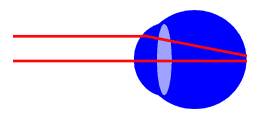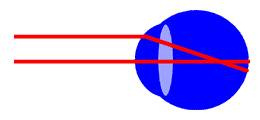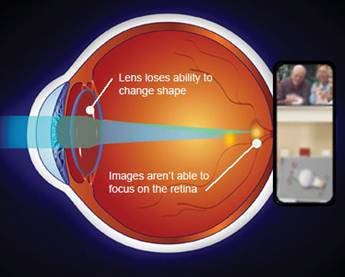In Astigmatism, an uneven curvature of the cornea blurs and distorts both distant and near objects. Normally, the cornea ( the front window of the eye) has a spherical shape, with the same curvature along all axes/sides, rather like a football. The astigmatic cornea is shaped a little more like a rugby ball, curved more in one direction than in another. As a result, light rays from different meridians (axes) are not all sharply focused onto the same area of the retina, hence distorting the visual image.
Most people have very slight astigmatism, but a significant number require spectacle or contact lens correction to see clearly. Advances in laser techniques allow astigmatism to be corrected with LASIK and LASEK.
Where astigmatism is present in patients undergoing cataract or clear lens surgery it can usually be dealt with at the same time, either using Toric intraocular lens implants or by carrying out Arcuate keratotomies. With the recent advances in Femtolaser assisted surgery, Arcuate keratotomies can be carried out even more precisely than before.
(LONG-SIGHTEDNESS)

In hyperopia, distant objects may be relatively clear, but close-up objects appear quite blurred. Hyperopia results from an eyeball that is essentially “too short” relative to the refractive powers of the eye. This causes the images to focus on a point behind the retina. This is the opposite of myopia. Hyperopes are more dependent on their spectacles/contact lenses for near objects, than for distant ones, but may require spectacles for both.
Many hyperopes are able to benefit from LASIK or other refractive surgery procedures such as Refractive Lens Exchange.
(SHORT-SIGHTEDNESS)

People who are Myopic or short-sighted, have an eye which is “too long” for the refractive powers of the cornea and lens. As a result, distant objects appear blurred because they are focused in front of the retina. Conversely, nearby objects are seen clearly and myopes can thus often read without glasses, even as they reach middle age.
Myopia affects about a third of the adult population and the majority of all refractive surgery patients are myopic. Many myopes are able to benefit from LASIK, LASEK or other refractive surgery procedures, such as Refractive Lens Exchange or Phakic Lens Implants.
When we are young we can accommodate (increase the focussing power of our eye) between distant and near objects. Those fortunate enough to be “normal sighted” will probably be able to read small print, nearly up to their nose, at the age of ten, but by the time they are fifty they will be struggling to read the same print at arms length in even the brightest light.

This loss of accommodation is part of the normal ageing process and results in blurring of near vision. As we age, the muscles supporting the lens of our eye become less effective and progressively unable to focus the lens for near vision. It is a perfectly normal but frustrating process starting in late childhood, though only producing symptoms years later.
Presbyopia affects absolutely everybody, although the age at which it begins to cause problems varies from one individual to another. Most people find that in their 40s they require reading glasses.
Hyperopic (long-sighted) people, who have worn glasses all their life for near vision, will now require bifocals or varifocals, as even distance vision is becoming blurred. Myopes (short-sighted people) in contrast often take their distance glasses off to read.
New surgical techniques such as PRELEX (Presbyopic Lens Exchange) have been very successful in treating people with presbyopia. Enquire about our approach to the PRELEX procedure and we will explain how you can also take advantage of the very latest in Laser assisted lens replacement surgery.